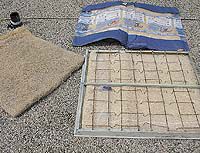| Fall is a good time to replace old pads like on the left with new ones like in the package and installed. |
It’s a task almost everyone hates doing. But if it isn’t done, some pretty drastic consequences can result.
That task is winterizing the swamp cooler that sits on top of most of the homes and businesses in Castle Valley.
Now that the warm weather is well past, and the temperatures are nearing freezing, it’s time to at the least shut off the water to the coolers tank. And even more should be done than that too.
Since swamp coolers do all their work with water, any water in the tank could cause problems when the temperatures drop below 32 degrees. So the tank should be drained. If no drain is present, as much of the water as possible should be scooped out.
While most people do maintenance in the spring, getting swamp coolers ready for the warm weather, some others swear by the practice of doing it in the fall.
First, residents should heck the pump to see that it is functioning properly before the water is shut off.
If not, a maintenance person will know that it will need replacement in the spring before he or she climbs to the roof.
Next is pads. Many people replace pads every couple of years. Others do it every year.
| One of the main tasks in winterizing a swamp cooler is to drain out the water. If there is no drain plug, this can be accomplished by using the pump and placing the discharge tube outside of the unit. |
There are advantages and disadvantages to changing pads in the fall.
The advantage is that, once the cover is removed from the cooler, it is pretty much ready to go.
The disadvantage is that even if the cooler is covered in the winter, dusts still settles in the pads and they will generally smell, whether new or used, in the spring.
With the increase in natural gas prices projected for the winter, fall may be the time that many people will want to do more than just cover the cooler with a canvas jacket.
Many people pack insulation around the cooler inside the cover or remove the grate from the cooler inside the home and stuff the vent with insulation.
This year might the time to do that if it hasn’t been done before. But once that is done, the cooler and the fan can’t be run until that insulation is removed.
While draining the water, there is also one other thing to remember. If the line that supplies the cooler can be exposed to the cold and has anywhere that water can stand in it, the line should be opened up and drained.
A good rule of thumb is to be sure that all areas of the line have a downhill slope toward the source of the water and that the line is disconnected in spots where water could sit, freeze and break the line.
Finally, the fall is a good time to check the electrical connections on the unit. Be sure the wiring is in good shape. Water, heat and cold take a toll on insulation. If insulation is bad it may be a good time to plan for repairs in the fall.

